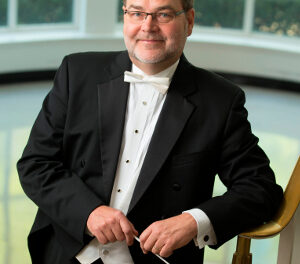A cycle of all nine Beethoven symphonies began during a concert by the Hendersonville Symphony Orchestra on Saturday, October 13, at the Hendersonville High School Auditorium that also featured virtuoso Canadian violinist Lara St. John.
Logically enough, the Beethoven cycle started with Symphony #1 in C Major. Hearing the now-familiar first measures, one appreciates how well Beethoven managed his early career. His Opus 21 symphony pays careful homage to the greatness that went before (Mozart and Haydn) but demonstrates that even within the bounds of classical form, Beethoven is a creative genius. It might have occurred to Haydn to use a simple C major scale ingeniously at the beginning of the fourth movement, as Beethoven does. But the young genius begins the first movement with a succession of chords that avoid a straightforward statement of the C major tonality, while definitely establishing the tonality within a few measures. That harmonic sequence would never have occurred to his predecessors. And while the third movement is labeled a “menuetto,” it is in reality the first of what will become standard in his later symphonies, a “scherzo.” In many ways an outwardly classical symphony, the first symphony sets new directions announcing, “Beethoven is here.”
The Hendersonville Symphony Orchestra provided a superior straight-down-the-middle performance of the Beethoven with few deviations. In the first movement, we did hear some first violinist add an unfortunate note where a rest is called for, but otherwise the strings distinguished themselves. The middle movements were exceptional. Each string section seemed fully aware of the entire score of the Andante Cantabile, which made the counterpoint seem like chamber music. The runs in the Menuetto were agile and delicate. This is not to downplay the work of the other sections. The brass had a good night also. In particular the trumpets, which in some community orchestras tend to sound crass, provided appropriate emphasis and presence without ever being obtrusive. First trumpet Larry Black (retired after 33 years in the Atlanta Symphony Orchestra) is a great addition to this orchestra.
The Beethoven symphony was preceded by the little-played Overture to King Stephan from the same composer’s incidental music to a play of that name. The musical material reflects the Hungarian subject matter of the play, and was an appropriate opener for a concert whose second half was dominated by a Hungarian theme. The works were Maurice Ravel’s Tzigane and Pablo de Sarasate’s Zigeunerweisen.
Born in London, Ontario, Lara St. John and her brother Scott St. John were both child prodigies. They performed the Bach double violin concerto with the Windsor Symphony Orchestra when they were 4 and 6 years old. Now in their thirties, Scott is a member of the famed St. Lawrence Quartet, while Lara has an international solo career. She is fortunate enough to play on an exquisitely responsive 1779 Guadagnini violin known as the “Salabue.”
Is there such a term as an adult prodigy? The astounding technical virtuosity that St. John displayed during the Ravel would justify such a phrase. This was my first live hearing of Tzigane, which begins with an extended cadenza filled with fast vibratos, double stopping, and a whole toolbox of technical wizardry. But the cadenza is not just fireworks; it establishes thematic material for the remainder of the work. The jazz-like muted trumpet and orchestral fortissimos that accompany later portions show Ravel’s own virtuosity as an orchestrator.
Zigeunerweisen is modeled after Franz Liszt’s Hungarian rhapsodies. Perhaps not as intimidating to the soloist, and certainly not as sophisticated a composition as the Ravel, it is a well-known crowd pleaser and a good choice to end a concert. Maestro Joiner and the orchestra were highly attentive to the extreme rubato imposed on them by the emotional and expressive nature of the piece.
An encore was called for, and some unaccompanied J.S. Bach was delivered. This enticing sample generated a great deal of interest in Ms. St. John’s newly released recording of the six Bach Sonatas and Partitas for Solo Violin, a shipping carton of which sold out following the concert. While the two “Gypsy” pieces had appealed to surface emotions, the Bach encore gave us confidence that this violinist can deliver serious content with a depth of expression and intelligent articulation. She seems as one with the Guadagnini violin, which in her hands provided its own resonance that overpowered and disregarded the poor acoustics of the hall.
To attendees at a pre-concert lecture, Music Director & Conductor Thomas Joiner explained the five-year plan for the Beethoven cycle: two symphonies each year for four seasons, and then the choral Ninth Symphony in season 2011-2012. He mused about what stage might hold the musical resources needed for the Ninth Symphony. “Let’s hope it’s not here,” was his remark, referring to the high school. Until the proposed Mill Center for the Arts is a reality (perhaps for the 2011-2012 season and the Ninth Symphony?), the HSO audiences will continue to be short-changed. They will never really hear how good their orchestra is. The musician’s play to the best of their abilities but a lot of fine detail of their playing is swallowed up by acoustic gremlins and never reaches the audience.











